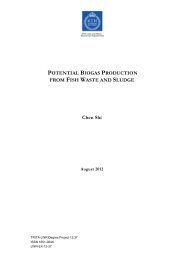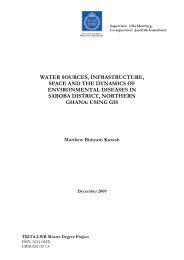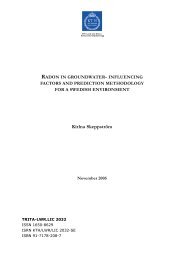Ignacio Valcárcel LencinaTRITA LWR Masters Thesisair trapping in <strong>the</strong> former or vertical accelerations on<strong>the</strong> latter, <strong>and</strong> <strong>the</strong>ir range of application depends on<strong>the</strong>m.The validity of <strong>the</strong> shallow water approach was basedon comparisons of <strong>the</strong> model against problems with aknown analytical solution, which has been done bymany researchers over <strong>the</strong> past years.Concerning comparisons with in situ measurements,Quecedo applied <strong>the</strong> shalow water approach <strong>to</strong>simulate <strong>break</strong>ing of a tailing <strong>dam</strong> in East Texas. All<strong>the</strong>se comparisons do not concentrate on intervalswhere vertical accelerations are important, like <strong>the</strong>initial instants following failure, or <strong>the</strong> interaction withobstacles like vertical dykes. In <strong>the</strong>se cases, <strong>the</strong> errorscan be important.Quecedo used a more accurate approach <strong>to</strong> assess <strong>the</strong>validity of <strong>the</strong> shallow water approach in <strong>the</strong>se casesfor which no known analytical solutions are available.Based on <strong>the</strong> results obtained, <strong>the</strong> authors concludedthat:(i) The shallow water approach predicts (i) faster floodwaves when propagating over dry beds, thus providingsafer predictions of flood wave arrival times, (ii)reasonable estimations of <strong>the</strong> evolution of water depthfar from <strong>the</strong> <strong>dam</strong>.(ii) If failure takes place on<strong>to</strong> a wet bed, <strong>the</strong> shallowwater results can be considered reasonable incomparison <strong>to</strong> those obtained using <strong>the</strong> Navier–S<strong>to</strong>kesapproach.(iii) If <strong>the</strong> free surface curvature is high, <strong>the</strong> shallowwater approach misspredicts <strong>the</strong> pressure. Thus, itshould not be used <strong>to</strong> calculate, for instance, stresseson structures.In spite of <strong>the</strong> shortcomings of <strong>the</strong> shallow waterapproach when applied <strong>to</strong> <strong>dam</strong> <strong>break</strong> problems, <strong>the</strong>computational effort required by o<strong>the</strong>r methods, suchas <strong>the</strong> Navier–S<strong>to</strong>kes Level-Set algorithm presentedherein, in actual problems makes <strong>the</strong> shallow waterapproach attractive for large computational domains.The Navier–S<strong>to</strong>kes approach would be used for <strong>the</strong>analyses of small areas when knowledge of <strong>the</strong> threedimensionalstructure of <strong>the</strong> flow is needed.2.2 One-dimensional Shallow Water equations.Once we have seen that <strong>the</strong> shallow water equations(from now on “SWE”) are <strong>the</strong> most suitable <strong>to</strong>describe <strong>the</strong> <strong>dam</strong> <strong>break</strong> problem, <strong>the</strong> next step is <strong>to</strong>describe <strong>the</strong>m for <strong>the</strong> one-dimensional approach.The SWE are frequently used for modelling bothoceanographic <strong>and</strong> atmospheric fluid flow. Models ofsuch systems lead <strong>to</strong> <strong>the</strong> prediction of areas eventuallyaffected by pollution, coastal erosion, <strong>and</strong> polar icecapmelting.As previously seen in [2.1], comprehensive modellingof <strong>the</strong> <strong>dam</strong> <strong>break</strong> using physical descriptions such as<strong>the</strong> Navier-S<strong>to</strong>kes equations can often be problematic,due <strong>to</strong> <strong>the</strong> scale of <strong>the</strong> modeling domains. The SWE,of which <strong>the</strong>re are a number of representations,provide an easier description of such phenomena.The SWE are obtained from <strong>the</strong> Navier-S<strong>to</strong>kesequations, assuming that vertical velocities <strong>and</strong>accelerations are negligible <strong>and</strong> integrating over <strong>the</strong>water depth.This <strong>1D</strong> model investigates <strong>the</strong> settling of <strong>the</strong> <strong>dam</strong><strong>break</strong>wave over a variable bed as a function of time.A ma<strong>the</strong>matical relation represents <strong>the</strong> shape of <strong>the</strong>bed so that is easy <strong>to</strong> change parameters.The <strong>1D</strong> Saint-Venant’s-SWE are <strong>the</strong> following:∂z∂(zv)+ = 0∂t∂x2∂(zv)∂(zv ) ∂z∂zf+ + g ⋅ z ⋅ + g ⋅ z ⋅∂t∂x∂x∂x22∂ ( zv)∂ ( zv)−υc⋅ + g ⋅ z ⋅ Sf − E ⋅ = 022∂x∂xOr in <strong>the</strong> compact form:∂z+ ∇ ⋅ ( zv)= 0∂t∂(zv)T+ ∇ ⋅ ( zvv ) + g ⋅ z ⋅∇zS∂t−υ⋅ ∆(zv)+ g ⋅ z ⋅ Sf − E ⋅ ∆(zv)= 0cWhere z is <strong>the</strong> thickness of <strong>the</strong> water layer (m), v is <strong>the</strong>velocity (ms -1 ), g <strong>the</strong> gravity constant (m s –2 ), Sf is <strong>the</strong>friction term (explained later) <strong>and</strong> υ c <strong>the</strong> kinematicviscosity (m 2 s -1 ). The wind effect is not present in<strong>the</strong> equations.The dispersion coefficient E has been set <strong>to</strong> 2 m 2 /s.This value takes in<strong>to</strong> account <strong>the</strong> turbulence <strong>and</strong> <strong>the</strong>heterogeneity of <strong>the</strong> velocity on <strong>the</strong> vertical. It is amajor unknown in <strong>the</strong> case of <strong>dam</strong> <strong>break</strong>, but <strong>the</strong>results that we will see later, show that ComsolMultiphysics has need of artificial diffusion forstabilizing its solution.The definition of <strong>the</strong> thickness of <strong>the</strong> water layer, z, isz s -z f , where z s <strong>and</strong> z f are <strong>the</strong> measures in figure 1.(1)(2)(3)(4)4
<strong>Comparison</strong> <strong>between</strong> <strong>1D</strong> <strong>and</strong> <strong>2D</strong> <strong>models</strong> <strong>to</strong> <strong>analyze</strong> <strong>the</strong> <strong>dam</strong> <strong>break</strong> waveFigure 1. Representative vertical section through <strong>the</strong> fluiddomain showing <strong>the</strong> bed of a lake <strong>and</strong> <strong>the</strong> water surface.2.3 Two-dimensional Shallow Water equations.Depth averaging of <strong>the</strong> free surface flow equationsunder <strong>the</strong> shallow water hypo<strong>the</strong>sis leads <strong>to</strong> a commonversion of <strong>the</strong> two dimensional SWE, wich inconservative form is:∂z∂(zu)∂(zv)+ + = 0∂t∂x∂y∂(zu)∂(zu+∂t∂x2) ∂(zuv)+∂y(5)∂z∂zf (6)− f ⋅ zv + g ⋅ z ⋅ + g ⋅ z ⋅∂x∂x22∂ ( zu)∂ ( zu)+ g ⋅ z ⋅ Sfx− E ⋅ − E ⋅ = 022∂x∂y∂(zv)∂(zuv)∂(zv+ +∂t∂x∂y+ g ⋅ z ⋅ Sf2)∂z∂zf (7)+ f ⋅ zu + g ⋅ z ⋅ + g ⋅ z ⋅∂y∂yy22∂ ( zv)∂ ( zv)− E ⋅ − E ⋅ = 022∂x∂yThe equations above are valid under <strong>the</strong> followingassumptions:1. The fluid is well-mixed vertically with a hydrostaticpressure gradient.2. The density of <strong>the</strong> fluid is constant.3. We study water waves of long wave lengths.4. The viscosity term is negligible.Where z is <strong>the</strong> depth of water, zu <strong>and</strong> zv are unitdischarges along <strong>the</strong> co-ordinate directions. Inaddition, u <strong>and</strong> v are <strong>the</strong> velocities in <strong>the</strong> x <strong>and</strong> ydirections respectively, g is <strong>the</strong> acceleration due <strong>to</strong>gravity <strong>and</strong> Sf x <strong>and</strong> Sf y are <strong>the</strong> friction terms in <strong>the</strong> x<strong>and</strong> y directions respectively. The turbulent dissipationterms (E) <strong>and</strong> Coriolis effect (f) are present in <strong>the</strong>equations, but not <strong>the</strong> wind effect, which is notsignificant in <strong>the</strong> usual valleys where <strong>the</strong> <strong>dam</strong>-<strong>break</strong>occurs.2.3.1 The friction term.Many two-dimensional depth-averaged <strong>models</strong> includeonly friction at <strong>the</strong> bot<strong>to</strong>m. Specifically, <strong>models</strong> thatassume vertical channel side-walls <strong>and</strong> use free-slipboundary conditions do not account for <strong>the</strong> friction at<strong>the</strong> walls. Neglecting this effect, open channel flowwould likely show a marked variation in water depthfrom <strong>the</strong> one measured experimentally.Evaluation of <strong>the</strong> friction slope that quantifies <strong>the</strong>energy loss at <strong>the</strong> side-walls of <strong>the</strong> channel is required.It is common <strong>to</strong> use a uniform flow law, Manning orChezy formulae, <strong>to</strong> calculate this term. However, <strong>the</strong>selaws were developed for one-dimensional flow <strong>and</strong>must be extended <strong>and</strong> properly incorporated <strong>to</strong> twodimensionalequations.Manning’s formula used in one-dimensional shallowwater<strong>models</strong> is expressed in <strong>the</strong> formSfn2A⋅ Q ⋅ Q= (8)2⋅ R4 / 3Where n is <strong>the</strong> Manning coefficient <strong>and</strong> R = A/P is <strong>the</strong>hydraulic radius, which depends on <strong>the</strong> wettedperimeter P. For a rectangular channel P = b + 2z<strong>and</strong> for an irregular basin P = b.A distinction must be made <strong>between</strong> an arbitrarychannel cross-section <strong>and</strong> a cross-section with verticalwalls (fig. 2). Most two-dimensional <strong>models</strong> assumevertical walls <strong>and</strong> free-slip wall boundary conditionsfor rectangular channels, while <strong>the</strong> equations used <strong>to</strong>compute <strong>the</strong> friction term are based on irregular crosssections.To correct this inconsistency, <strong>the</strong> frictionslope equation has been modified here <strong>to</strong> reflect <strong>the</strong>vertical side-wall assumption. Basically, <strong>the</strong>modification ensures that <strong>the</strong> entire wetted perimeter(bot<strong>to</strong>m width <strong>and</strong> side-walls) is accounted for.For an arbitrary cross-section, <strong>the</strong> wetted perimeter ina cell is equal <strong>to</strong> <strong>the</strong> bot<strong>to</strong>m width b (fig. 2), so that <strong>the</strong>hydraulic radius adopts <strong>the</strong> form R = z, <strong>the</strong> waterdepth. In this case, <strong>the</strong> two-dimensional friction termsare written in <strong>the</strong> form (Brufau <strong>and</strong> García-Navarro2000):22n ⋅ u ⋅ u +Sf x 4/ 3zv2= (9)22n ⋅ v ⋅ u +Sf y 4 / 3zv2= (10)5
















